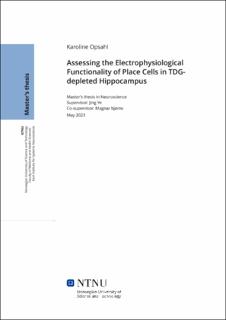| dc.contributor.advisor | Ye, Jing | |
| dc.contributor.advisor | Bjørås, Magnar | |
| dc.contributor.author | Opsahl, Karoline | |
| dc.date.accessioned | 2023-07-01T17:34:25Z | |
| dc.date.available | 2023-07-01T17:34:25Z | |
| dc.date.issued | 2023 | |
| dc.identifier | no.ntnu:inspera:149484403:37282929 | |
| dc.identifier.uri | https://hdl.handle.net/11250/3075247 | |
| dc.description.abstract | Når dyr utforsker nye omgivelser, dannes det romlige minner som oppdateres med erfaring og hentes frem igjen ved gjeneksponering for det samme miljøet. Koordinert modifikasjon av synaptisk styrke mellom de parahippocampale-hippocampale kretsenes spatiale celler antas å gi et sentralnevralt substrat for dette kognitive fakultetet. Disse strukturelle endringene i nevrale komposisjoner antydes å være avhengig av regulering av gentraskripsjon for proteinsyntese gjennom koordinering mellom DNA-metylering og demetylering. Den rapporterte rollen til DNA-glykosylasen, TDG, i demetylering insinuerer en mulig involvering av TDG i dannelse av langtidshukommelse, da denne typen hukommelse er avhengig av transkripsjonsregulering. Denne studien undersøker den potensielle effekten av TDG-mediert DNA-demetylering på hippocampus-avhengig spatial hukommelse. Mer spesifikt har denne studien som mål å undersøke den mulige innvirkningen av TDG på den proporsjonale fordelingen av plassceller i CA1 og deres funksjonelle plastisitet i en betinget Tdg knockout musemodell. Dette ble evaluert gjennom følgende prosedyrer. (I) Jeg konstruerte mikrodrivere med fire intrakranielle tetroder, som til sammen komponerte 16 elektroder. Disse ble implantert i musens hippocampus. (II) Deretter utførte jeg in vivo elektrofysiologisk opptak av celler i hippocampusområdet, CA1, hos fritt utforskende mus. Jeg registrerte aktiviteten til hippocampale celler i fire dyr (to kontroller og to TDG-reduserte). Spatiale celler ble underlagt in vivo global remapping og korttids og langtids stabilitetseksperimenter. (III) Jeg sorterte celler fra alle registrerte mus ved hjelp av klusterklippe- og analyseprogramvaren, Tint. (IV) Til slutt utførte jeg populasjonsanalyse for å identifisere spatiale celler og analyserte globale remapping- og stabilitetskapasiteten til plassceller. Resultatene mine impliserte at CA1 hos de betingede Tdg knockout-musene hadde en høyere andel plassceller, men færre hastighetsceller enn kontrollmusene. TDG-reduserte stedsceller viste lavere gjennomsnittlig romlig informasjonsrate og fyringsrate, men samme mengde informasjonsinnhold sammenlignet med kontrollcellene. Videre hadde TDG-reduserte celler lavere spesifisitet når det gjelder plassfeltenes toppfyringsrate, men antall stedsfelt per celle og feltstørrelse var konstant på tvers av genotyper. Ingen avvik fra normalitet ble observert i globale remapping-evner, men de betingede Tdg-knockout-cellene var mer ustabile både med 50 min og 24 timers mellomforsøksintervaller. Disse resultatene tyder på at funksjonaliteten til TDG-reduserte CA1-plassceller kan avvike fra funksjonaliteten til celler med normale mengder TDG. Celler fra flere mus bør inkluderes og evalueres for å kunne trekke en solid konklusjon. | |
| dc.description.abstract | When exploring new environments, animals form spatial memories that are updated with experience and retrieved upon re-exposure to the same environment. Coordinated alternation of synaptic strength in the parahippocampal-hippocampal circuitry spatial cells is thought to provide a central neural substrate for this cognitive faculty. These structural changes in neuronal motifs are suggested to rely on the regulation of gene transcription for protein synthesis by coordination of DNA methylation and demethylation. The reported role of the DNA glycosylase, TDG, in demethylation suggests a possible involvement of TDG in long-term memory formation, as this type of memory is dependent on transcriptional regulation. This study investigates the potential effect of TDG-mediated DNA demethylation in hippocampal-dependent spatial memory. More specifically, this study aims to examine the potential impact of TDG on the proportional arrangement of CA1 spatial cells and the functional plasticity of CA1 place cells in a conditional Tdg knockout mouse model. This was assessed by the following procedures. (I) I constructed microdrives wired with four intracranial tetrodes, composing 16 electrodes. These were implanted in the mouse hippocampus. (II) Then I performed in vivo electrophysiological recording of cells in the hippocampal area CA1 in freely exploring mice. I recorded the activity of hippocampal cells in four animals (two control and two TDG-depleted). Place cells were subjected to in vivo global remapping and short-term and long-term stability experiments. (III) I sorted cells from all recorded mice by the Tint cluster cutting and analysis software. (IV) Lastly, I performed population analysis to identify spatial cells and analyzed the global remapping and stability capabilities of place cells. My results suggested that CA1 from the conditional Tdg knockout mice had a higher proportion of place cells but fewer speed cells than the control mice. TDG-depleted place cells displayed lower spatial information rate and firing rate on average, but the same amount of information content compared to the control cells. Furthermore, the TDG-depleted cells had lower specificity in terms of place field peak firing rate, but the number of place fields per cell and field size was invariable across genotypes. No deviances from normality were observed in global remapping capabilities, but the conditional Tdg knockout cells were more unstable both with 50 min and 24 h inter-trial intervals. These results suggest that the functionality of TDG-depleted CA1 place cells may deviate from the functionality of cells without TDG depletion. Cells from more animals ought to be included and evaluated to make a robust conclusion. | |
| dc.language | eng | |
| dc.publisher | NTNU | |
| dc.title | Assessing the Electrophysiological Functionality of Place Cells in TDG-depleted Hippocampus | |
| dc.type | Master thesis | |
